ECUADOR
History

History
Cities in ECUADOR
| Quito |
Popular destinations ECUADOR
| Galapagos islands |
History
Pre-Columbian Era
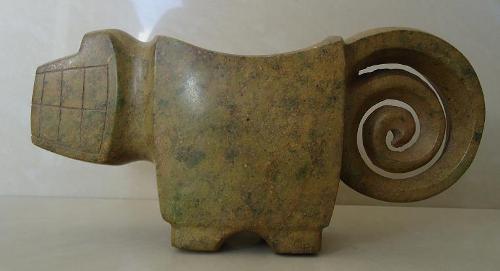 Pottery Valdivia Culture EcuadorPhoto: Germanum94 in the public domain
Pottery Valdivia Culture EcuadorPhoto: Germanum94 in the public domain
The first inhabitants of Ecuador were collectors, hunters and fishermen. The transition of these nomadic tribes to a formative way of life is thought to have occurred about 5,000 years ago. The pottery found from these cultures along the coast of Ecuador is the oldest ever found in both Americas and belongs to the so-called Valdivia culture. The oldest Valdivia settlement found dates back to around 3500 BC. and is called Loma Alta. Another important archaeological site is Real Alto, a real city with temples from around 1500 BC.
How this Valdivia culture developed in Ecuador is still unclear. A number of scientists saw strong similarities between the pottery of the Jomon culture on the Japanese island of Kyushu. However, real evidence that the Valdivia culture descends from Japan has never been found. Moreover, the pottery operations occur all over the world and are more the result of identical technical tools that people had. Polynesian descent theories are also unclear and have never been proven.
The Amazon region of Ecuador was also home to hunters and gatherers. However, agricultural experts discovered that as far back as 6,000 BC. the casave plant (manioc) was cultivated and cities with many thousands of inhabitants must have existed along the banks of the Amazon and on the slopes of the Ecuadorian Andes. Around 3000 BC. there had already been intensive trade contact between residents of the Costa and the Sierra. Evidence has been found in Cerro Narrio, a pre-Columbian trade center.
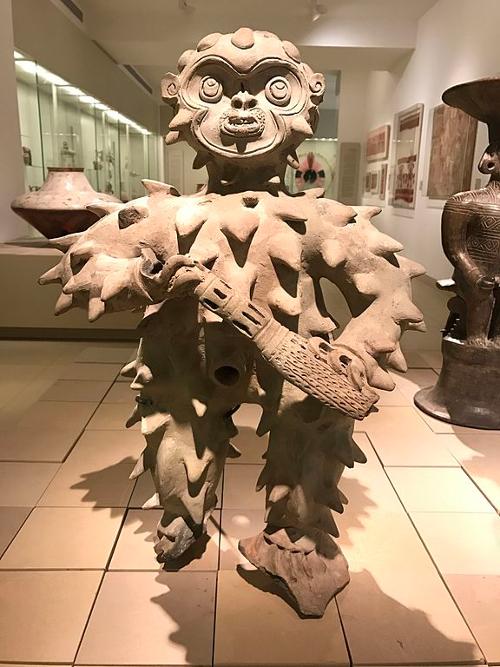 La Tolita mythological figure in feathered costume, EcuadorPhoto: Marsupium in the public domain
La Tolita mythological figure in feathered costume, EcuadorPhoto: Marsupium in the public domain
Before the Incas arrived, there was already a great cultural boom of different civilizations. The La Tolita culture reached its peak around 300 years BC. including in Northern Ecuador. This culture became famous for the many gold and platinum objects that have been found. Archaeologists believe that La Tolita Island was a pre-Columbian sacred site. Due to the very high melting point of platinum, it is very special that this culture managed to make such beautiful objects from platinum. The Manta culture existed in what is now the province of Manabí. They also made beautiful objects, and the city of Manta was home to more than 20,000 inhabitants. The Manta culture is further characterized by the extensive trade contacts with, among others, Western Mexico and Peru. They are also believed to have been the discoverers of the Galapagos Islands.
The La Tolita and Manta culture had disappeared by the mid-15th century and made way for farming communities , the so-called Sierra cultures. Mighty Sierra cultures were the Cañaris and the Caras. The Caras had strong ties to Amazonian tribes and initially lived in the northern coastal strip of Ecuador, but moved to the southern Sierra region in the 15th century. The spinning and weaving of sheep's wool was their main economic activity, and this people was led by one family, the Shyri family.
In the central part of the Sierra lived the Puruháof the Duchicela family. The Caras and the Puruhás went through a number of marriages together in the 14th century and around the city Quito the kingdom of Quitu was formed. These people fought many wars against the Cañaris and the soldiers recruited from the common population. Around this time, the Incas also entered the scene. Initially they lived in the Peruvian Andes and started to expand their empire from about 1430. Their battle against the Cañaris began around 1460 with the aim of conquering Quitu.
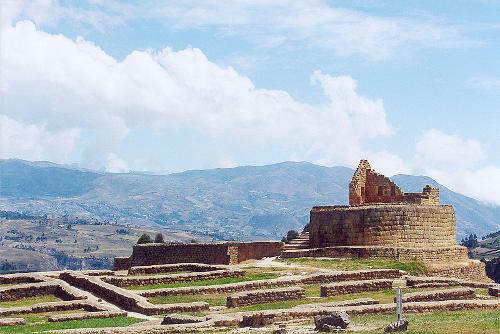 Ingapirca Inca ruins in EcuadorPhoto: Delphine Ménard CC 2.0 France no changes made
Ingapirca Inca ruins in EcuadorPhoto: Delphine Ménard CC 2.0 France no changes made
This battle was won by the Inca king Tupac-Yupanqui. The male population in the Cañaris area was almost completely exterminated because of revenge from the resistance of the Cañaris. Quito was conquered in 1492 and in the north, after 17 years of fighting, the Caras were defeated by Tupac's son, Huayna-Capac. In the footsteps of the Incas, many Quechua-speaking Indians from present-day Peru moved to Quito and the surrounding area and the Cañaris and Caras were deported to Peru. The Incas introduced the llama as a pack animal, new crops, irrigation methods and the road network of the Incas was extended to Quito. The inhabitants of Ecuador had to work for the Incas according to the Mita system: no taxes, but labor or the provision of services. Although the Inca rule was cruel and hostile, several Inca leaders married daughters of local kings' daughters. Intended as strengthening unity in the Inca Empire, just the opposite was achieved. The Incas were often already married to Inca princesses. This caused problems with succession to the throne between the children of both women, trueboth thought they were entitled to. After the death of Huayna-Cupac in 1527, Huascar became heir to the throne, much against Atuahalpa's wishes. A power struggle ensued that would last five years with Atuahalpa as the ultimate victor.
Spanish rule
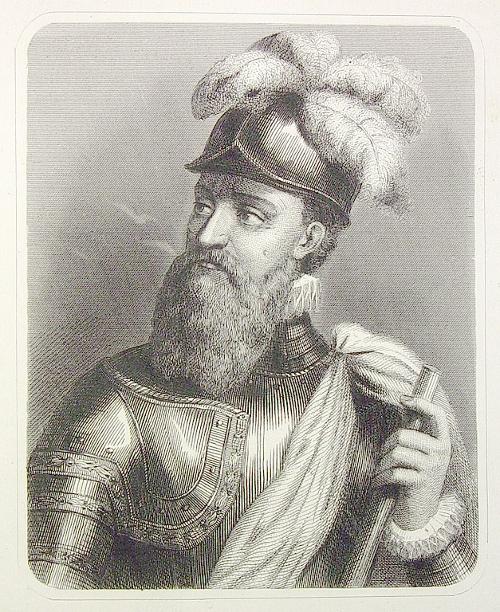 Francisco Pizarro, EcuadorPhoto: Fondo Antiguo de la Biblioteca de la Universidad de Sevilla CC 2.0 Generic no changes made
Francisco Pizarro, EcuadorPhoto: Fondo Antiguo de la Biblioteca de la Universidad de Sevilla CC 2.0 Generic no changes made
With the arrival of the Europeans, his rule would only last a few months. In 1526 the first Spaniards, often from the Spanish province of Extramadura, set foot on Inca soil. They were explorers of the Spanish explorer and conquistador Francisco Pizarro. The gold and silver rush soon struck among the Spaniards, and in 1531 Pizarro returned to conquer the area. After fierce battles with Indians and a journey of hardship, they reached the town where Atualhalpa lived, Cajamarca. Atahualpa was taken prisoner and stolen about 25 tons of gold under false pretenses. When they no longer needed him, he was charged with treason and put to death on the stranglehold. Several other conquistadors moved to the Inca area and that caused a lot of unrest there, and finally in 1549 the entire northern Inca- empire conquered by only 2,000 Spanish soldiers who had subdued 500,000 Indians. Only in 1554 was the administrative chaos restored by the fighting conquistadors. In 1563, present-day Ecuador was renamed Real Audiencia de Quito and would become part of the Viceroyalty of Peru until around 1700. A feudal agricultural system was introduced;the land was divided among the conquistadors, soon followed by the first Spanish settlers. The first slaves were also brought in from Africa to work on the cocoa plantations. Although gold and silver were still sought, it soon became clear that there was not nearly as much to be obtained as in Peru or Bolivia. Large-scale mining was therefore not done here.
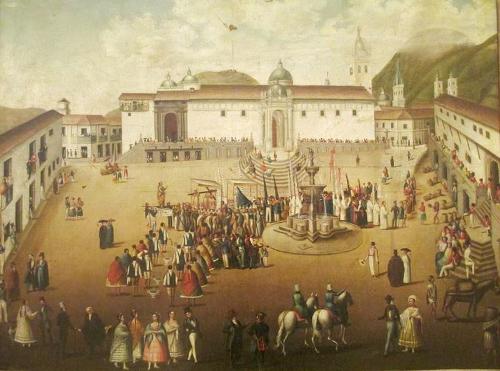 Major Square Quito in the18th century, EcuadorPhoto: Publlic domain
Major Square Quito in the18th century, EcuadorPhoto: Publlic domain
In Ecuador, on the other hand, the first exotic wheat and bananas were cultivated. The poor accessibility meant that most of the Ecuadorian Indian peoples were not threatened with extinction. The colonial policy of the Spaniards was based on the so-called "encomienda" and on the church. The encomienda system involved lending pieces of land to Spanish conquistadors, officials and settlers. They were responsible for the exploitation and management of the land, as well as the welfare of the Indians who lived on their land. However, the Indians earned so little that they had to go into debt to keep their heads above water. This system of exploitation was wholeheartedly supported by the church, which itself was also a large landowner. Conversion to the Catholic faith was also often carried out by force and force.
In 1835, the scientist Charles Darwin visited the GaláPagos Islands annexed by Ecuador. His observations contributed much to the development of the theory of evolution.
The Spanish oppression soon led to various independence movements. A.o. tax increases led to a ten-month uprising in 1592 that could only be stopped by the Spaniards with great violence.
Ecuador on the road to independence
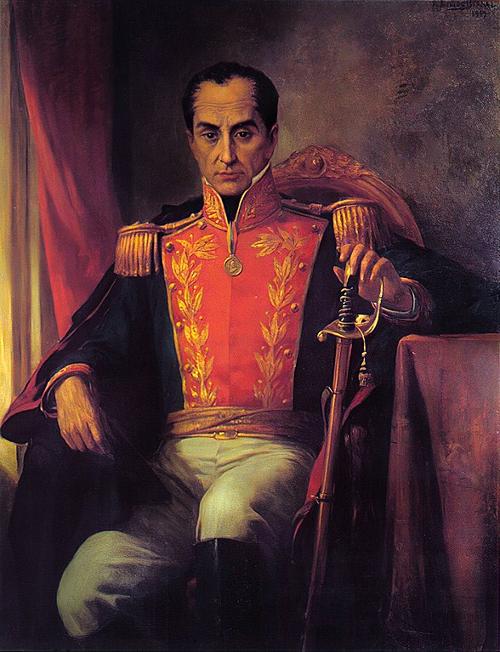 Simon Bolivar, EcuadorPhoto: Public domain
Simon Bolivar, EcuadorPhoto: Public domain
In the 18th century, the ideas of the Enlightenment penetrated into Ecuador and provided a breeding ground for the first coup d'état to take place in Quito in 1809. In 1808, the Spanish king Ferdinand VII was deposed by Napoleon. Resistance against this in Spain spilled over to the colonies when the new rulers in Europe unleashed a number of repressive laws on the colonies.
1809 took hold. a group of "criollo's" hold power in Quito. This revolt was crushed by the Spaniards with great violence. Two years later, another seizure of power followed, but it was simply suppressed by the Spanish. However, the road to independence became more and more open, even though the now returned king of Spain sent Ferdinand VII, a large force to the colonies to investigate the matter. regain control. The most important figure in the fight against the Spanish loyalists was the Venezuelan Simón Bolívar, the "liberator" (El Libertador). He conquered the present Colombia (then: New Granada) and Venezuela. In May 1822, Quito jurisdiction was liberated after the battle of Pichincha led by Antonio Joséthe Sucre. Bolívar wanted to unite the liberated countries in a republic or a federation called Gran Colombia. Venezuela, Colombia and the jurisdiction of Quito joined the Federation in 1822, but the Federation fell apart as early as 1830. Quito's Lieutenant Governor Juan JoséFlores proclaimed the Republic of Ecuador in September 1830 with the same boundaries as those of the jurisdiction. This happensHowever, he was not careful enough and would later lead to border disputes with Peru. The condition of the poor population hardly changed and political power was challenged by conservative Quito and liberal Guayaquil, or between the Costa and the Sierra. President Flores offered to rule the liberals in turn, with military authority remaining in Quito at all times. In 1843, however, Flores refused to step down for the liberal Rocafuerte. Two years later, the liberals seized power and Flores was deposed, but for the next 15 years, Ecuador had eleven governments and the constitution was rewritten three times. As a result, the economy completely stagnated. There were also various border problems with Colombia and Peru. On the positive side, slavery was officially abolished in 1852.
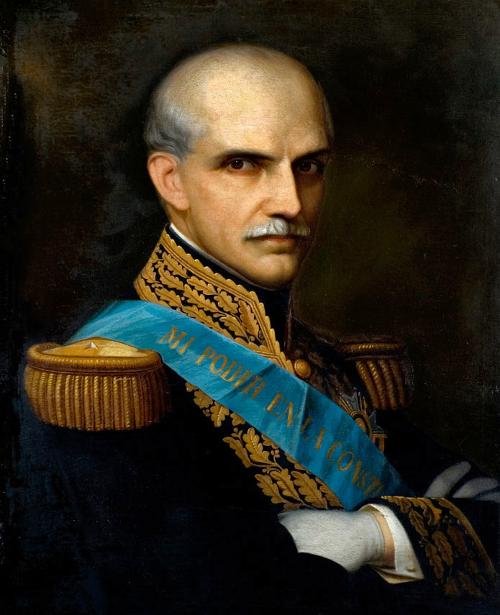 Gabriel García Moreno, EcuadorPhoto: Public domain
Gabriel García Moreno, EcuadorPhoto: Public domain
In 1860, a conservative revolt led by one of the most important figures in Ecuadorian history, Gabriel García Moreno, wanted to make Ecuador a theocracy . The very Catholic but tyrannical Moreno forbade, among other things, the freedom of expression and of the printing press and non-practicing Catholics and dissenters were deprived of citizenship. However, he managed to restore calm in Ecuador and it also improved economically. In 1875 Moreno was assassinated and in 1895 the power of the conservatives came to an end.
Twentieth century
By 1900, the liberal Eloy Alfaro was in power and his economic policy sought to cooperate with the capitalist states, but he too was murdered, now by Catholic fundamentalists. This was the result of the introduction of the separation between church and state.
Between 1914 and 1925, Ecuador went through an economic slump that was accompanied by a lot of social unrest. A military coup in 1925 was followed by the dictatorship of Isidro Ayora, which carried out fiscal and economic reforms. The return of liberal rule in 1931 led to the introduction of women's suffrage.
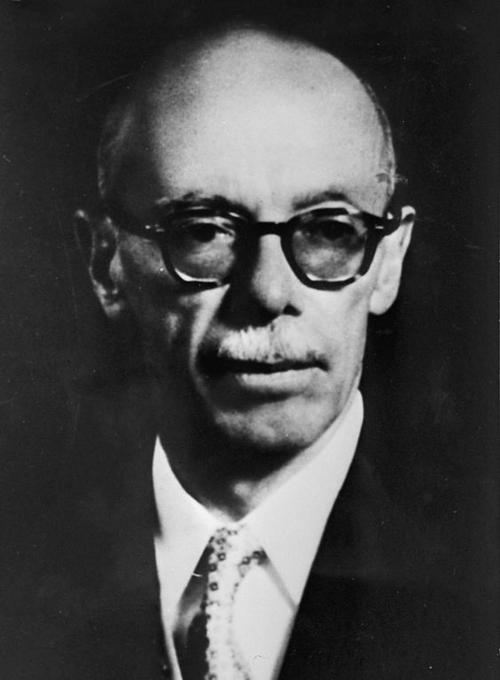 José María Velasco Ibarra, EcuadorPhoto:Unknown CC 3.0 Netherlands no changes made
José María Velasco Ibarra, EcuadorPhoto:Unknown CC 3.0 Netherlands no changes made
Military juntas ruled the country in the second half of the 1930s. Difficult international economic conditions, political instability and a new war with Peru formed the background to the growing national crisis. The climate was then ripe for a populist demogologist like JoséMaria Velasco Ibarra who was president of Ecuador for five terms between 1933 and 1972. Velasco's position, maneuvering skilfully between left and right, depended on his strong, direct bond with the population and later, as that bond diminished, on the support of the military. His reign was characterized by the drawing up of promising programs for public works, industrialization and land reform, but also by the failure to implement all the beautiful plans. During his reign, the border conflict with Peru flared up regularly. In 1941, half of Ecuador's territory was occupied by the Peruvians without much resistance. In 1942 the Rio de Janeiro protocol ratifying the border shift was concluded. Ecuador also signed the treaty, but would later challenge it.
In the 1960s and 1970s, the economy grew steadily, and as a result, the political front was a bit quieter. Banana exports in particular grew enormously. In 1964, a land reform was implemented that brought an end to the system of large land ownership (haciendas) and serfdom. Large deposits of oil were discovered in 1967 and are still the cornerstones of the economy today.
Early in 1972, the military overthrew Velasco to prevent the presidential election to be held that year. General Rodriguez Lara, who belonged to the left-nationalist, so-called Peruvian wing of the armed forces, became president. However, he did not pursue a truly progressive social policy, but did pay ample attention to the national economy. In early 1976, Rodriguez Lara was overthrown and replaced by a junta announcing the gradual return to civilian rule.
On January 15, 1978, a new constitution was passed, granting universal suffrage. In 1979, center-left Jaime Roldós Aguilera was elected president. He promised social and economic reforms in favor of the common people, but was unlucky that the oil price on the world market plummeted, so that all the beautiful plans could no longer be realized. The resurgence of conflict over the portion of the Amazon that Ecuador had lost to Peru in 1941 led to a border war between the two countries in 1981.
In 1981, Roldós was killed in a plane crash. Vice President Osvaldo Hurtado took his place and tried to continue the policies of his predecessor. However, he was also unlucky: major floods caused enormous damage to roads, railways and the rice and banana crops. Hurtado fired the commander in chief ofthe armed forces and the Defense Secretary, who opposed his attempts at reconciliation with Peru. The 1984 elections were won by the conservative Léon Febres Cordero. His pursuit of a free-market economy and authoritarian style of government caused much social unrest and political instability.
A coup by Air Force General Frank Vargas followed, but failed and Vargas was captured. In 1987 Febres was kidnapped by Vargas supporters. Febres was only released when he granted Vargas amnesty. In 1988 the elections were won by the Social Democrat Rodrigo Borja Cevallos. He too introduced numerous reforms and especially wanted to curb high inflation. He had to take unpopular measures that led to many strikes.
His successor Sixto Durán Ballén tried to make Ecuador a stable country economically and politically by decentralization, modernization and privatization. Implementation of the economic adjustment program was difficult in the first half of the 1990s, as the government continually clashed with an opposition majority in parliament and unions and Indian organizations also fiercely resisted. The May 1994 parliamentary elections resulted in a severe defeat of the parties of President Durán Ballén.
In 1995, another series of border incidents with Peru followed in which dozens were killed. International observers have been monitoring compliance since the April 1995 armistice. Durán was succeeded in 1996 by the eccentric AbdalaláBucaram (El loco = the madman), who won a lot of votes in the lower social classes thanks to beautiful promises. The food and housing programs he initiated generated a lot of enthusiasm among the population. However, it turned out to be all hot air and soon he started gigantic austerity operations and in a very short time Ecuador ended up in the middle of an economic crisis. On February 6, 1997, he was impeached by parliament for “mental incapacity”.
Temporary head of state became Fabian Alarcon. The May 1998 presidential election was won by the mayor of Quito, Jamil Mahuad Witt, after a necessary second round. In August 1998 a new constitution was adopted. In October 1998, the governments of Peru and Ecuador reached an agreement defining the border between the two countries in the Amazon region. Ecuador also got the right to navigate the Amazon River. The bad economic situation led to a free fall in the value of the sucre in early 1999. The government's measures to combat the crisis met opposition from trade unions, but on March 18, President Mahuad reached an agreement with the opposition on a moderate austerity package.
After months of negotiations, the IMF approved a $ loan at the end of August. 400 million estate on the condition of an increase in taxes and a reform of the financial system. In early October, the government suspended payments (interest and installments) on the $ 13 billion external debt, which led to a credit freeze by foreign financial institutions.
21st century
Since January 22, 2000, Gustavo Noboa Bejarano has been president after a coup against incumbent president Mahuad. Hundreds of Indians, along with a group of soldiers, stormed the parliament buildings in the capital, Quito. The Ecuadorian army asked Mahuad to resign in order to find a democratic solution to the crisis in the country.
In November 2002, the volcano El Reventador (3560 meters) became active again after a 26-year hiatus. The mountain began to emit a great deal of gas, smoke, and ash. The mountain is located about 100 kilometers east of the capital, Quito, and even caused a lot of nuisance there.
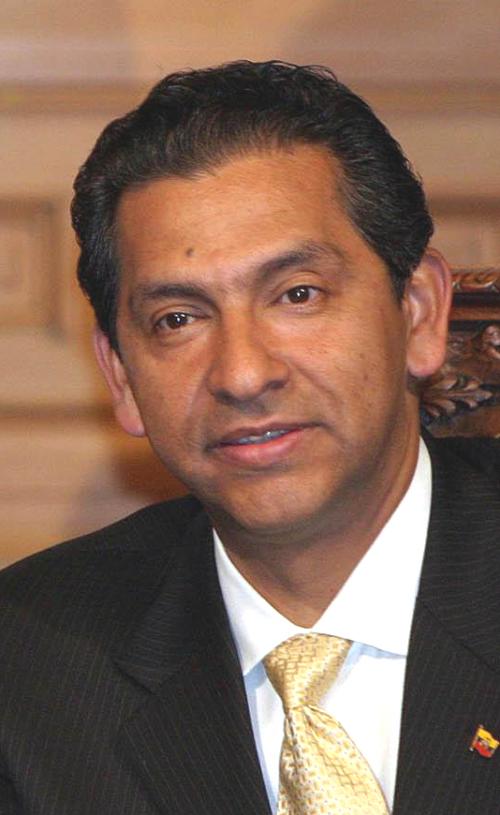 Lucio Gutiérrez Borbua, EcuadorPhoto:Antônio Milena/ABr CC 3.0 Brazil no changes made
Lucio Gutiérrez Borbua, EcuadorPhoto:Antônio Milena/ABr CC 3.0 Brazil no changes made
The November 2002 elections were won by former Colonel Lucio Gutiérrez Borbua of the 'Partido Sociedad Patriótica' (PSP). Gutiérrez was part of the coup against President Mahuad. Initially, the president mainly received support from left-wing and indigenous groups. Since he took office, however, this support turned into criticism of his orthodox economic policy in line with his predecessors. Gutiérrez was not appreciated when he replaced 27 of the 31 high justices in December 2004. Then a national crisis ensued when Supreme Court President Guillermo Castro Dager passed the conviction of ex-President Bucaram (his childhood friend and political ally) moved in. Bucaram returned from exile in Africa and declared "I am older and wiser, but crazier than ever!". To pacify the enraged protesters, Gutiérrez announced the resignation of the Supreme Court while alsodeclared a state of emergency. Four people lost their lives in disturbances between the protesters and the counter-protesters called in by the government. Congress forced the president to step down for his irresponsible behavior and dictatorial traits. The army declared that it would not act against its own people and no longer support the president. Gutiérrez fled his palace by helicopter to apply for asylum at the Brazilian embassy. Bucaram also fled the country again for asylum in Panama.
Former Vice President Alfredo Palacio has ruled the country since April 19, 2005 and is the seventh president in nine years. The 66-year-old cardiologist Palacio, who has previously been critical of Gutiérrez, is not affiliated with a political party. The discontent expressed in the popular protests was not only directed against Gutiérrez, it was an expression of discontent and distrust of the entire political class. Palacio therefore faces the challenge of restoring democracy and gaining the people's confidence in it. Palacio made several attempts at political reform, all of which were rejected by Congress. In a transparent process with technical assistance and monitoring from the UN, OAS and Spain, a new Supreme Court was set up.
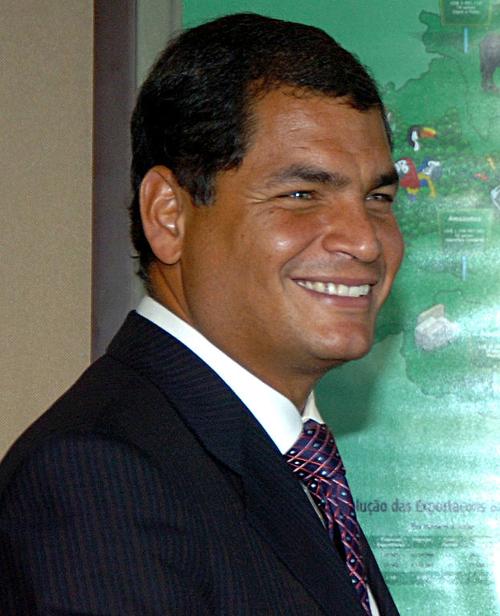 Rafael Correa, EcuadorPhoto: Roosewelt Pinheiro/Abr CC 3.0 Brazil no changes made
Rafael Correa, EcuadorPhoto: Roosewelt Pinheiro/Abr CC 3.0 Brazil no changes made
In November 2006, left-wing economist Rafael Correa won the elections. On January 15, 2007, he was naugurated as the eighth president in ten years.
In March 2008, a crisis arises with Colombia due to a border crossing through Colombia In June diplomatic relations are again maintained at a low level . In April 2009, Correa won the presidential election with a 51% majority in the first round. In April 2010, the government threatens to take over foreign oil concessions if those companies stop allowing state intervention.
In late September and early October 2010, Ecuador was ravaged by violent riots. Police officers rebelled against reforms and austerity measures that entailed a decline in their incomes and privileges. The government declared a state of emergency after the building housing President Correa was surrounded by angry agents. At least two people were killed in the protests. In May 2011, voters vote in favor of a reform program of President Correa, opponents think the president is taking too much power. In February 2013 Correa wins the elections again. He threatens to resign in October if parliament allows abortion. In October 2014, the constitutional court allowed parliament to prepare constitutional changes to extend the deadlines for the presidency. In December 2015, there will be demonstrations after the parliament actually takes this decision. President Correa pledges that he will not stand for re-election in 2017. He was succeeded by Lenin Morena, who won the May 2017 tournaments. In 2018, per referendum, a president may serve a maximum of two terms. In 2019 there are massive protests from indigenous people against the increase in fuel prices. Guillermo Lasso, a liberal supporter of the free market, ended 14 years of centre-left rule when he won the 2021 presidential election, narrowly beating his socialist opponent Andes Arauz.
Sources
Ecuador
Cambium
Luft, A. / Reishandboek Ecuador en de Galápagoseilanden
Elmar,
Rachowiecki, R. / Ecuador & the Galápagos islands
Lonely Planet
Renterghem, O. van / Ecuador : mensen, politiek, economie, cultuur
Koninklijk Instituut voor de Tropen/Novib
Vries, W. de / Ecuador, Galápagos
Gottmer
CIA - World Factbook
BBC - Country Profiles
Copyright: Team The World of Info